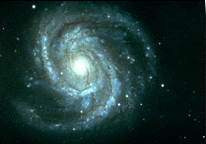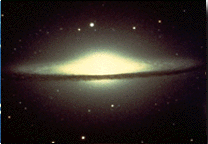
The Sun takes about 200 million years to complete one orbit around the centre.
Spiral Galaxy fly-through animation (Quicktime Viedo)

Spiral galaxies are rich in gas and dust.
Spiral galaxies
The galaxies come in a variety of shapes, with the distribution of shapes depending in a way not yet completely understood on the evolution of the galaxies. Our galaxy has arms of younger stars and gas that appear to spiral out from the centre. In fact the objects in these spiral arms are in almost circular orbits about the centre of the Galaxy. The Sun takes about 200 million years to complete one orbit around the centre. About 30 percent of all galaxies have spiral arms. Some have arms that spiral directly from the nucleus while others have a linear feature, called a bar, from whose ends the arms originate. The adjacent figure shows a nice spiral galaxy, M100, which is in the Virgo cluster (click on the image to display a larger image). Another beautiful example of a spiral galaxy is M83. Presumably our own galaxy would resemble these galaxies in appearance if we could view it from the outside.
Spiral galaxies are rich in gas and dust. Some are viewed face-on so that the spiral arms are easily seen whereas others are viewed edge-on. These show the presence of dust lanes which obscure the starlight coming from near the midline of the disk. We see this in our galaxy where the Milky Way is divided into two portions for much of its length. Indeed, as we have noted above, the centre of the Milky Way galaxy is invisible in ordinary light because the interstellar dust in that direction is so thick.
